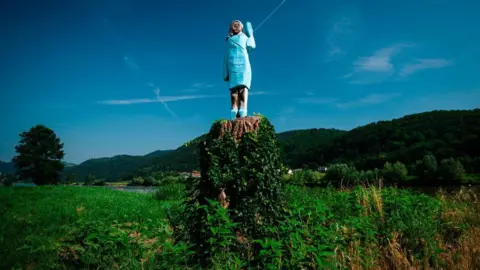Melania Trump Statue Disappearance: A Tale of Art, Legacy, and Local Sentiment
Melania Trump’s legacy extends far beyond the United States. In her hometown of Sevnica, Slovenia, artistic tributes have become unexpected symbols of both admiration and controversy. Recently, the disappearance of a bronze Melania Trump statue captured global attention and reignited conversations about art, politics, and local pride.

The Disappearance of the Melania Trump Statue
Not long ago, police in the Slovenian village of Rozno—close to Sevnica—opened an investigation after Melania Trump’s bronze statue mysteriously vanished. Reports indicate that the monument, which stood beside a scenic river, was sawed off at the ankles, leaving only its feet and a portion of the tree trunk behind. Authorities are treating the case as theft and have begun gathering evidence at the scene. Still, many questions remain about the motivation behind this brazen act. CNN covers the police investigation and provides background on the statue's history.
An Artistic Journey Marked by Turmoil
The statue’s journey started in July 2019. Conceptual artist Ales "Maxi" Zupevc, a local born in the same hospital as Melania Trump, sculpted the original piece from a single block of wood. The depiction—modeled after Melania’s iconic blue inauguration dress—drew mixed reviews among locals and tourists. The attention, however, soon turned negative. In 2020, vandals set the statue on fire during US Independence Day celebrations. The charred remains were later exhibited in art galleries, both in Slovenia and Croatia.
Following the arson, American artist Brad Downey commissioned a more durable bronze version for the original site. He hoped this new iteration would resist vandalism and continue to honor Sevnica’s famous daughter. Yet, as the BBC highlights, the statue’s disappearance shows that even the most resilient materials are not immune to controversy and mischief.
Local Sentiments and Global Attention
Sevnica’s relationship with Melania Trump remains complex. On one hand, the town has benefited from increased tourism and the sale of Melania-themed products like honey, chocolate, and cakes. On the other, the statue’s existence and repeated attacks have underscored deeper divisions. Some locals voiced that “the image of the US First Lady was not something anyone was proud of,” reflecting a mix of pride, ambivalence, and skepticism.
Brad Downey, the artist behind the bronze tribute, has long asserted the work’s political nature. By collaborating with Zupevc—himself a symbol of local heritage and resilience—Downey sparked important conversations about immigration, identity, and the symbolism attached to public monuments. The case of the vanished Melania Trump statue challenges communities to reflect on whose stories earn a place in public art, and for how long.
Conclusion: A Symbol Beyond Its Form
The disappearance of Melania Trump’s statue in Slovenia is about more than a missing work of art. It reveals the complicated ways in which public figures, especially those with global influence, shape local narratives. As investigations continue and local authorities seek answers, the statue’s story stands as a testament to art’s power to provoke dialogue—and sometimes, division. For a more in-depth look at the statue’s saga, readers can explore reputable sources like CNN's detailed report and the BBC’s coverage.
What began as a tribute to Melania Trump has become a reflection of broader debates about history, representation, and memory. How Sevnica and the art world choose to respond will shape the legacy of this controversial statue for years to come.